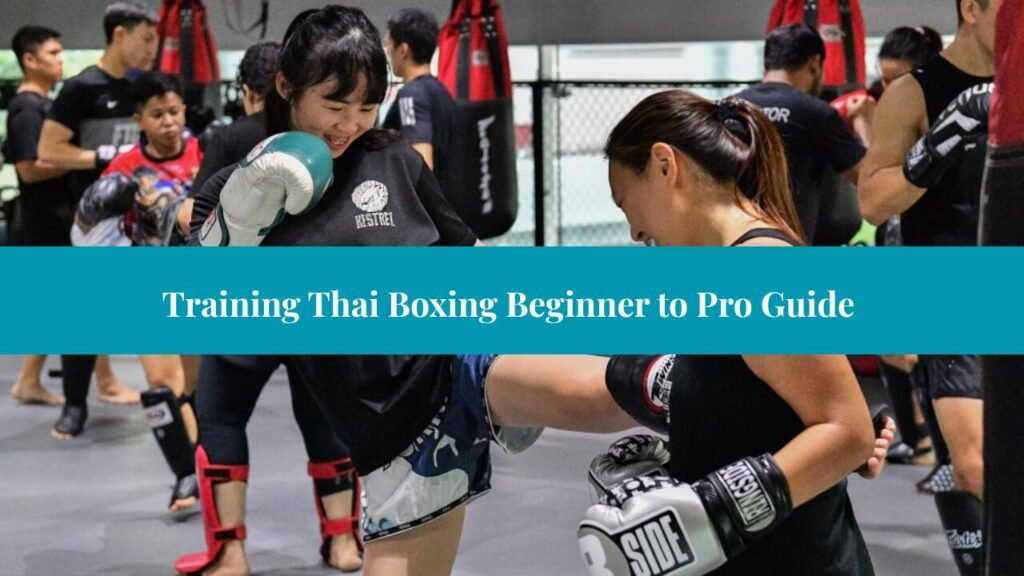Muay Thai, often referred to as “The Art of Eight Limbs,” is a powerful and dynamic combat sport originating from Thailand. With its emphasis on punches, kicks, elbows, and knees, training Thai boxing offers physical and mental benefits unlike any other martial art. Whether you’re looking to get fit, learn self-defense, or enter the ring competitively, this guide will walk you through everything you need to know about training Thai boxing as a beginner.
What is Thai Boxing (Muay Thai)?
Muay Thai is Thailand’s national sport, combining traditional martial arts techniques with modern combat sports training. Practitioners use their entire body as a weapon, making it one of the most effective striking arts in the world.
Key Features of Muay Thai:
- Utilizes 8 points of contact (hands, elbows, knees, and shins)
- Emphasizes clinching and sweeps
- Offers a full-body workout
- Builds mental toughness, discipline, and respect
Why You Should Start Training Thai Boxing
Physical Benefits
- Cardiovascular Health: Muay Thai is a high-intensity workout that boosts endurance.
- Weight Loss: You can burn 700-1000 calories per session.
- Strength and Conditioning: Enhances core, legs, and upper body strength.
- Flexibility and Agility: Dynamic movements improve overall mobility.
Mental Benefits
- Confidence Boost: Learning effective self-defense techniques builds self-assurance.
- Stress Relief: Hitting pads and focusing on training clears the mind.
- Discipline and Focus: Regular practice instills mental resilience.
Cultural Appreciation
- Connect with Thai traditions and rituals
- Learn respect and humility through traditional wai kru rituals
Getting Started with Muay Thai Training
Finding the Right Gym
Look for gyms that offer authentic Muay Thai instruction with certified coaches. Some reputable options include:
- Evolve MMA – Known for world-class instructors
- KST Muay Thai – Offers programs for all skill levels
Questions to Ask Before Joining:
- Are the trainers certified in Muay Thai?
- Is the gym clean and well-equipped?
- Do they offer trial classes?
- What’s the student-to-coach ratio?
What to Expect in Your First Class
Most beginner classes include:
- Warm-up: Jump rope, shadowboxing, and dynamic stretches
- Technique Drills: Basic punches, kicks, and knees
- Pad Work: Hitting Thai pads or focus mitts
- Conditioning: Bodyweight exercises or circuit training
- Cool Down: Light stretching and recovery
It’s normal to feel overwhelmed in your first few classes. Be patient, and remember that every expert was once a beginner. Focus on mastering the basics, and improvements will come with time.
Essential Gear for Thai Boxing
- Hand Wraps: Protects your wrists and knuckles
- Boxing Gloves: Usually 12-16 oz for training
- Shin Guards: Essential for sparring
- Mouthguard: Protects your teeth during contact drills
- Muay Thai Shorts: Designed for freedom of movement
- Athletic Cup (for men): Adds protection during sparring
- Ankle Supports: Helps reduce the risk of ankle injuries
Investing in quality gear can help prevent injuries and ensure a more enjoyable training experience.
Basic Muay Thai Techniques for Beginners
Punches
- Jab: Quick straight punch from the lead hand
- Cross: Power punch from the rear hand
- Hook: A curved punch to the side of the opponent’s head
- Uppercut: A vertical punch targeting the chin
Kicks
- Roundhouse Kick: Thrown using the shin for maximum impact
- Teep (Push Kick): Used for creating distance or disrupting your opponent’s rhythm
- Low Kick: Targets the thigh to weaken your opponent’s stance
Elbows
- Horizontal Elbow: A slicing strike across the face
- Upward Elbow: A sneaky strike that rises under the opponent’s guard
- Spinning Elbow: Advanced technique used to surprise the opponent
Knees
- Straight Knee: Drives into the opponent’s midsection
- Jumping Knee: Often used in close-range fighting
- Diagonal Knee: Used in the clinch to strike ribs or kidneys
Clinch and Sweeps
- Clinch Control: Dominating your opponent with neck and arm control
- Sweeps: Using leverage and timing to unbalance your opponent
- Off-Balancing: Essential in setting up knees and throws
How Often Should You Train?
Beginners
Start with 2–3 sessions per week to build endurance and muscle memory. Make sure to leave a day between classes for recovery. In this stage, consistency is more important than intensity.
Intermediate to Advanced
4–6 times a week, including:
- Technical drills
- Sparring
- Strength & conditioning
- Rest and recovery
Rest is just as important as training. Overtraining can lead to injury and burnout. Make use of active recovery techniques like yoga or swimming to stay mobile and healthy.
Common Challenges and How to Overcome Them
Physical Fatigue
- Stay hydrated and eat nutrient-rich meals
- Get enough sleep and listen to your body
- Include light activity or massage on rest days
Learning Curve
- Don’t rush—focus on proper technique
- Ask for feedback and film your sessions
- Break down complex techniques into manageable steps
Bruises and Soreness
- Use ice and take Epsom salt baths
- Wear proper gear and train smart
- Accept that some discomfort is part of progress
Mental Plateaus
- Mix up your routine to stay motivated
- Set short-term and long-term goals
- Surround yourself with positive training partners
Real Experiences from Beginners
Many new students at KST Muay Thai report feeling intimidated at first but quickly gain confidence. One student shared:
“At first, I was overwhelmed by the pace and terminology. But the coaches broke everything down, and after a few weeks, I felt like part of a family. I lost weight, gained muscle, and found a new passion.”
Others have used Muay Thai to recover from mental health issues or build self-esteem.
Nutrition and Recovery for Muay Thai Athletes
Proper fuel is essential for optimal performance in Muay Thai.
Pre-Workout
- Complex carbs like oatmeal, brown rice, or whole grain toast
- Moderate protein (eggs or lean meats)
- Hydration: 500ml of water 1–2 hours before class
Post-Workout
- Lean protein (chicken, tofu, eggs) for muscle recovery
- Fast-absorbing carbs like bananas or smoothies
- Electrolyte replenishment with coconut water or sports drinks
Supplements (Optional)
- Whey protein for muscle building
- BCAAs for recovery
- Magnesium for muscle relaxation
Home Training Tips
Even if you can’t make it to the gym, you can still improve with solo practice.
Shadowboxing
- Practice movement, technique, and combinations
- Use a mirror to correct your form
Conditioning
- Bodyweight exercises: push-ups, squats, lunges, planks
- Jump rope for cardio and footwork
Bag Work (if you have a heavy bag)
- Practice combinations
- Work on timing and accuracy
- Train for rounds (3 min work, 1 min rest)
Muay Thai and Self-Defense
Muay Thai’s emphasis on powerful strikes, balance, and clinch control makes it highly effective for self-defense. Unlike some traditional martial arts, it focuses on real-world application under pressure. You learn to:
- Stay calm during confrontation
- Defend against multiple angles
- Use effective counter-attacks
It’s not just about aggression, but also situational awareness and control.
Watch “Muay Thai for Beginners” on YouTube to visually reinforce your training
FAQs
How long does it take to get good at Muay Thai?
With consistent training, most people see significant improvement in 3–6 months. Mastery takes years. The key is consistency, proper coaching, and a positive mindset.
Is Muay Thai dangerous for beginners?
Not if you train smart. Always use proper gear, and start with non-contact drills before sparring. Most gyms take safety seriously and gradually introduce contact work.
Can I train Muay Thai to get fit without fighting?
Absolutely. Many students train solely for fitness, never stepping into the ring. The conditioning is intense, making it one of the best full-body workouts.
How is Muay Thai different from kickboxing?
Muay Thai uses elbows, knees, and clinch work making it more versatile than traditional kickboxing, which primarily focuses on punches and kicks.
Do I need to be in shape before starting?
No, Muay Thai will help you get into shape. Just start at your own pace. Many beginners start with no experience and quickly build strength and endurance.
Conclusion
Training Thai boxing offers more than just self-defense or athletic development; it’s a pathway to personal transformation. With benefits ranging from improved fitness to mental resilience, there’s no better time to start your Muay Thai journey.
Whether you’re training to fight or just to feel better in your own skin, Muay Thai welcomes everyone. So wrap your hands, lace up your gloves, and take the first step toward becoming stronger inside and out.
For more information, visit boxing essential for Muay Thai or Evolve MMA for beginner-friendly programs.




